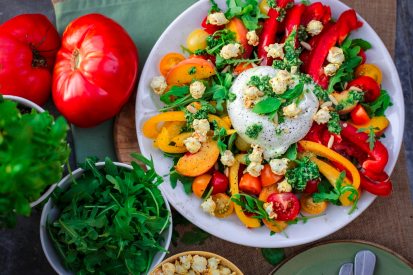LEARN ABOUT FOOD – EARN A LIFE THAT IS SO ENDLESSLY DELICIOUS
We are indeed much more than what we eat, but what we eat can nevertheless help us to be much more than what we are !
You can enjoy your meals while making small adjustments to the amounts of food on your plate. Healthy meals start with more fruits, vegetables, grains, protein foods, and dairy. Drink and eat less sodium, saturated fat, and added sugars.
Take our LLET advices to find out what kinds of foods and how much to eat … and to get tips and support for making better food choices.
Let’s start…
All humans have to eat food for growth and maintenance of a healthy body, but we humans have different requirements as infants, children (kids), teenagers, young adults, adults, and seniors. For example, infants may require feeding every four hours until they gradually age and begin to take in more solid foods. Eventually they develop into the more normal pattern of eating three times per day as young kids. However, as most parents know, kids, teenagers, and young adults often snack between meals. Snacking is often not limited to these age groups because adults and seniors often do the same.

Tips:
- Eat three meals a day (breakfast, lunch, and dinner); it is important to remember that dinner does not have to be the largest meal;
- The bulk of food consumption should consist of fruits, vegetables, whole grains, and fat-free or low-fat milk products;
- Choose lean meats, poultry, fish, beans, eggs, and nuts (with emphasis on beans and nuts).
- Choose foods that are low in saturated fats, trans fats, cholesterol, salt (sodium), and added sugars; look at the labels because the first listed items on the labels comprise the highest concentrations of ingredients;
- Control portion sizes; eat the smallest portion that can satisfy hunger and then stop eating.
- Snacks are OK in moderation and should consist of items like fruit, whole grains, or nuts to satisfy hunger and not cause excessive weight gain;
- Avoid sodas and sugar-enhanced drinks because of the excessive calories in the sodas and sugar drinks; diet drinks may not be a good choice as they make some people hungrier and increase food consumption;
- Avoid eating a large meal before sleeping to decrease gastroesophageal reflux and weight gain;
- If a person is angry or depressed, eating will not solve these situations and may make the underlying problems worse;
- Avoid rewarding children with sugary snacks; such a pattern may become a lifelong habit for people;
- Avoid heavy meals in the summer months, especially during hot days;
- A vegetarian lifestyle has been promoted for a healthy lifestyle and weight loss; vegetarians should check with their physicians to be sure they are getting enough vitamins, minerals, and iron in their food;
- Cooking foods (above 165 F) destroys most harmful bacteria and other pathogens; if you choose to eat uncooked foods like fruits or vegetables, they should be thoroughly washed with running treated (safe to drink) tap water right before eating;
- Avoid eating raw or undercooked meats of any type.
Tips for special situations:
- People with diabetes should use the above tips and monitor their glucose levels as directed; try to keep the daily blood glucose levels as close to normal as possible;
- People with unusual work schedules (night shifts, college students, military) should try to adhere to a breakfast, lunch, and dinner routine with minimal snacking;
- People who prepare food should avoid using grease or frying foods in grease;
- People trying to lose weight (body fat) should avoid all fatty and sugary foods and eat mainly vegetables, fruits, and nuts and markedly reduce his/her intake of meat and dairy products;
- Seek medical advice early if you cannot control your weight, food intake, or if you have diabetes and cannot control your blood glucose levels.

Healthy food groups
- vegetables and legumes/beans;
- fruit;
- lean meats and poultry, fish, eggs, tofu, nuts and seeds, legumes/beans;
- grain (cereal) foods, mostly wholegrain and/or high cereal fibre varieties;
- milk, yoghurt, cheese and/or alternatives, mostly reduced fat.
Eating a varied, well-balanced healthy meals means eating a variety of foods from each food groups daily, in the recommended amounts. It is also important to choose a variety of foods from within each food group because different foods provide different types and amounts of key nutrients. Choosing a variety of foods will help to make your meals interesting, so that you don’t get bored with your meals.
Occasional foods
Some foods do not fit into the five food groups because they are not necessary for a healthy meal. These foods are called ‘discretionary choices’ and they should only be eaten occasionally. They tend to be too high in either energy (kilojoules), saturated fat, added sugars, added salt or alcohol, and have low levels of important nutrients like fibre.
Examples of ‘discretionary choices’ or occasional foods are:
- sweet biscuits, cakes, desserts and pastries;
- processed meats and fattier/salty sausages, savoury pastries and pies, commercial burgers with a high fat and/or salt content;
- sweetened condensed milk;
- ice cream and other ice confections;
- confectionary and chocolate;
- commercially fried foods;
- potato chips, crisps and other fatty and/or salty snack foods including some savoury biscuits;
- cream, butter and spreads which are high in saturated fats;
- sugar-sweetened soft drinks and cordials, sports and energy drinks and alcoholic drinks.
Small allowance for healthy fats
 Unsaturated fats are an important part of a healthy diet. The two main types of unsaturated fats are monounsaturated fats (found in olive and canola oil, avocados, cashews and almonds) and polyunsaturated fats like omega-3 fats (found in oily fish) or omega-6 fats (found in safflower and soybean oil and Brazil nuts).
Unsaturated fats are an important part of a healthy diet. The two main types of unsaturated fats are monounsaturated fats (found in olive and canola oil, avocados, cashews and almonds) and polyunsaturated fats like omega-3 fats (found in oily fish) or omega-6 fats (found in safflower and soybean oil and Brazil nuts).
These fats can help reduce the risk of heart disease and lower cholesterol levels when they replace saturated fats in the meal. It’s good to include a small allowance for healthy fats each day (around 1–2 tablespoons for adults and less for children). The best way to include healthy fats in your diet is to replace saturated fat that you may currently be eating (such as butter and cream) with a healthier, unsaturated fat option (such as polyunsaturated margarine or olive oil).
How to include food groups in your meals
It’s not hard to include foods from the five food groups into snacks and meals. Some suggestions include:
 Vegetables and legumes – raw or cooked vegetables can be used as a snack food or as a part of lunch and dinner. Salad vegetables can be used as a sandwich filling. Vegetable soup can make a healthy lunch. Stir-fries, vegetable patties and vegetable curries make nutritious evening meals. Try raw vegetables like carrot and celery sticks for a snack ‘on the run’.
Vegetables and legumes – raw or cooked vegetables can be used as a snack food or as a part of lunch and dinner. Salad vegetables can be used as a sandwich filling. Vegetable soup can make a healthy lunch. Stir-fries, vegetable patties and vegetable curries make nutritious evening meals. Try raw vegetables like carrot and celery sticks for a snack ‘on the run’.
 Fruit – this is easy to carry as a snack and can be included in most meals. For example, try a banana with your breakfast cereal, an apple for morning tea and add some berries in your yoghurt for an afternoon snack. Fresh whole fruit is recommended over fruit juice and dried fruit. Fruit juice contains less fibre than fresh fruit and both fruit juice and dried fruit, and are more concentrated sources of sugar and energy. Dried fruit can also stick to teeth, which can increase the risk of dental caries.
Fruit – this is easy to carry as a snack and can be included in most meals. For example, try a banana with your breakfast cereal, an apple for morning tea and add some berries in your yoghurt for an afternoon snack. Fresh whole fruit is recommended over fruit juice and dried fruit. Fruit juice contains less fibre than fresh fruit and both fruit juice and dried fruit, and are more concentrated sources of sugar and energy. Dried fruit can also stick to teeth, which can increase the risk of dental caries.
Bread, cereals, rice, pasta and noodles – add rice, pasta or noodles to serves of protein and vegetables for an all-round meal. There are many varieties of these to try. Where possible, try to use wholegrains in breads and cereals.
 Lean meat, fish, poultry, eggs, nuts, legumes and tofu – these can all provide protein. It’s easy to include a mixture of protein into snacks and meals. Try adding lean meat to your sandwich or have a handful of nuts as a snack. You can also add legumes to soups or stews for an evening meal.
Lean meat, fish, poultry, eggs, nuts, legumes and tofu – these can all provide protein. It’s easy to include a mixture of protein into snacks and meals. Try adding lean meat to your sandwich or have a handful of nuts as a snack. You can also add legumes to soups or stews for an evening meal.
 Milk, yoghurt and cheese – try adding yogurt to breakfast cereal with milk, or using cottage cheese as a sandwich filling. Shavings of parmesan or cheddar can be used to top steamed vegetables or a salad. Use mostly reduced fat products.
Milk, yoghurt and cheese – try adding yogurt to breakfast cereal with milk, or using cottage cheese as a sandwich filling. Shavings of parmesan or cheddar can be used to top steamed vegetables or a salad. Use mostly reduced fat products.
after all…
Be careful dear LLET friend – you should eat only when you are hungry and drink only when you are thirsty !!!



